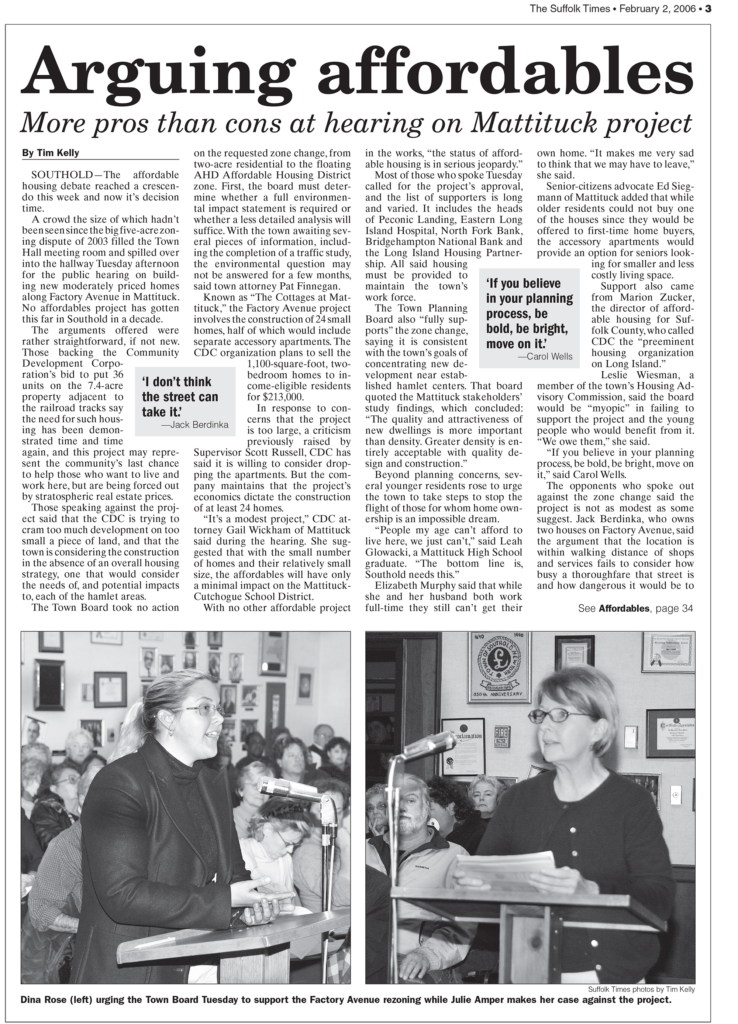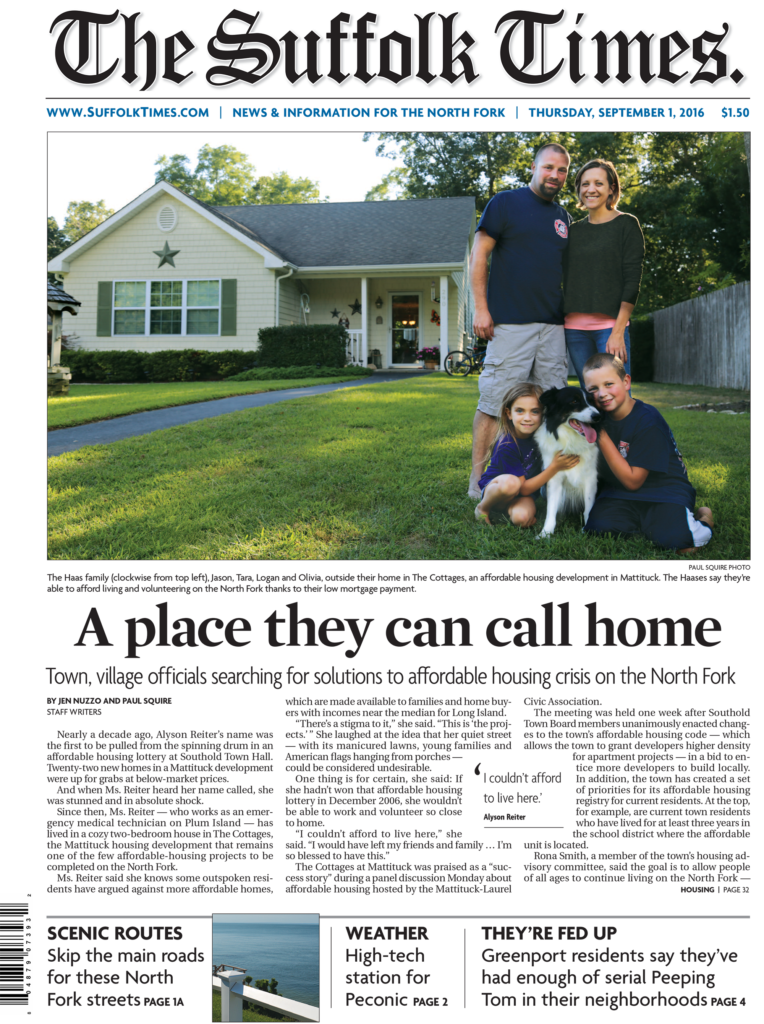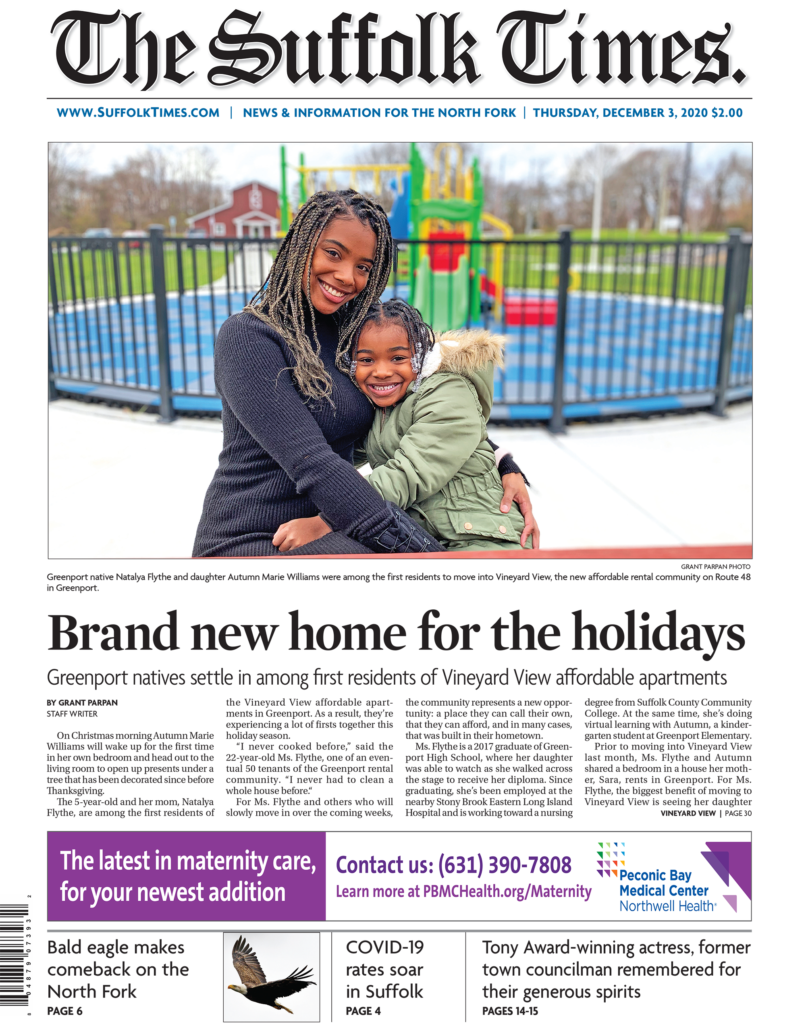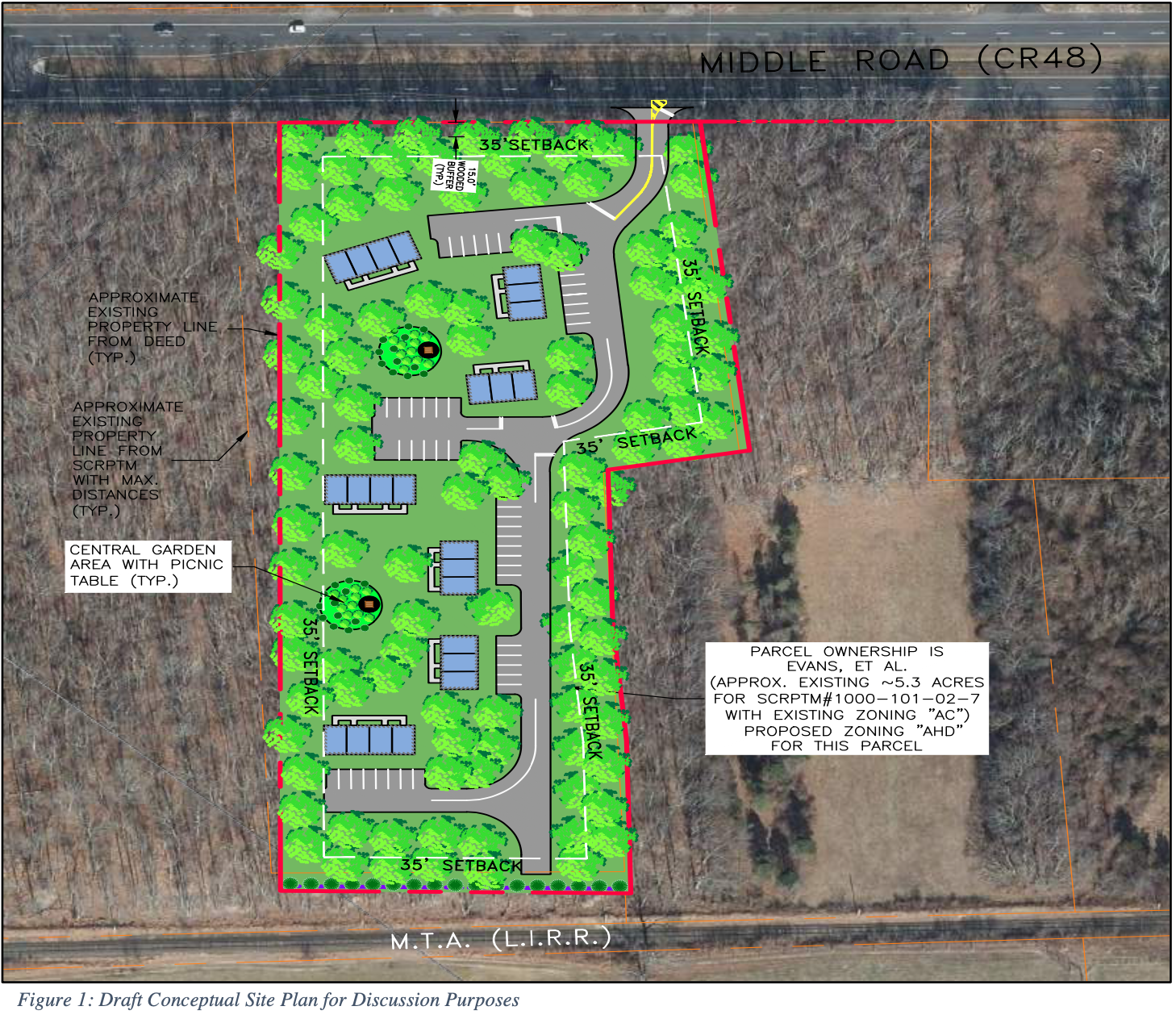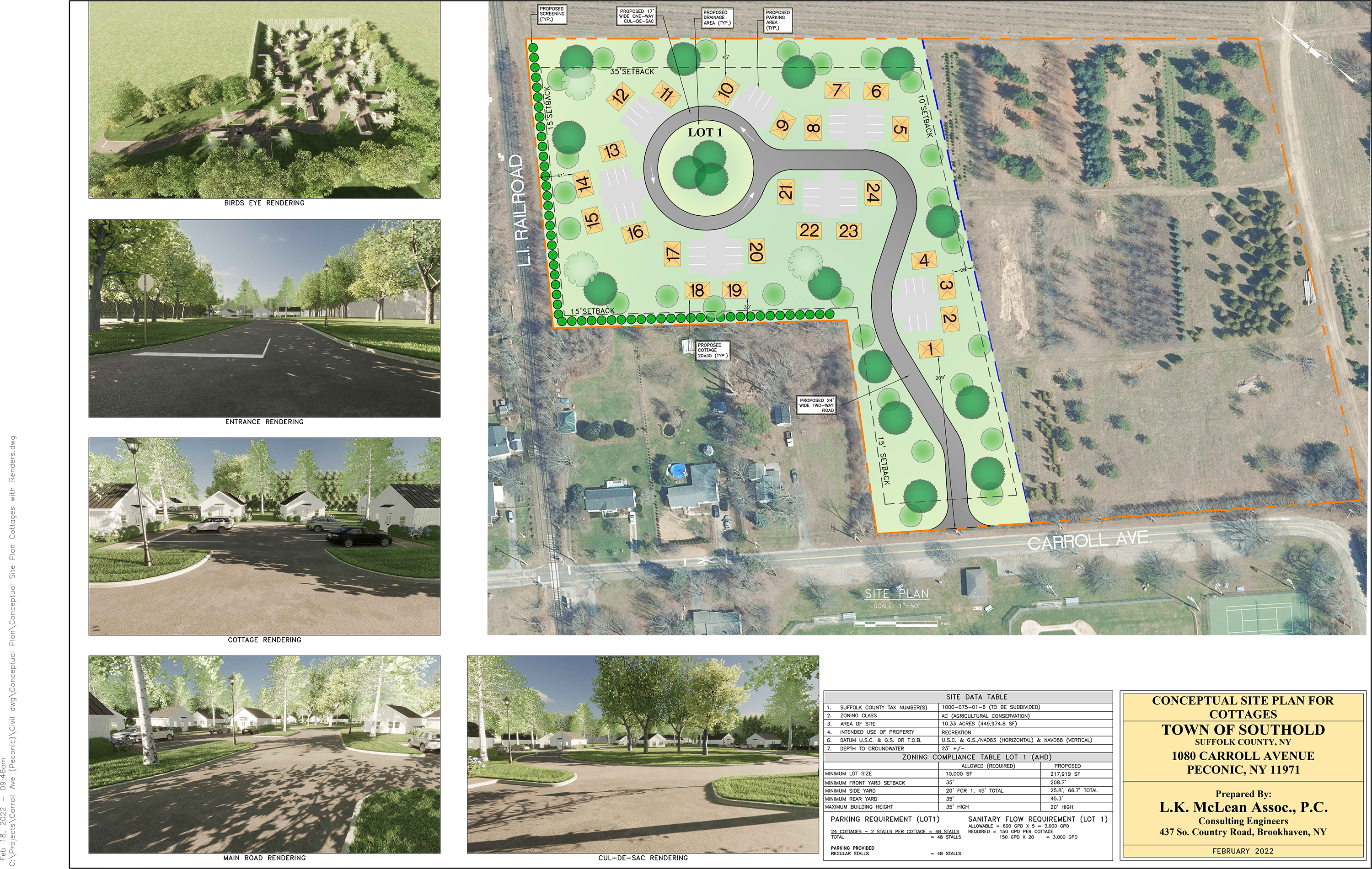The North Fork’s affordable housing ‘crisis’ has reached new extremes
Lifelong North Fork residents are moving away. Government employees are struggling to live in the town they serve, health care workers can’t stay near their patients, fire departments are hurting for volunteers and businesses are struggling with staffing shortages. The Town of Southold is facing, like the rest of the New York City metro area, an affordable housing crisis. At the end of 2021, the affordable housing registry — a list that changes daily — averaged between 350 and 400 names.

This crisis is not new. Go through past issues of The Suffolk Times, minutes from town hall meetings — people have been talking about the lack of housing in Southold for years. Most of Southold Town’s more than 14,000 homes are single-family dwellings and only 10% are available for rent year-round, compared with 21% in the county overall. Thirty-seven percent of housing makes up second homes, creating the perfect storm to raise house prices and hurt rental availability.
According to the town’s comprehensive plan, single-family homes in Southold tripled in price between 1990 and 2005, beyond the increase in the town’s median income. Low housing inventory and vacation rentals have exacerbated this issue.
And it’s only gotten worse during the pandemic.
“This is a crisis on steroids,” said Pat Lutsky of the Southold Housing Advisory Commission. “The changes in the real estate market since COVID became part of our lives has exacerbated the problem. I see it in the everyday people I come across. It’s like ‘Hi, how are you doing, by the way, do you know a place for rent?’ Homeowners have been selling their homes at record speeds and at record levels. There just aren’t places for people to go.”
The federal Department of Housing and Urban Development considers housing unaffordable if costs exceed 30% of total household income. The Southold Town comprehensive plan cites the American Community Survey 2012-2016 Five Year Estimate, which found nearly 50% of renters and more than 30% of homeowners in Southold Town pay more than 30% of their income on housing.
“These statistics show that residents are overextending themselves to live in Southold,” the comprehensive plan says. “Many Southold families could not afford their present home if they were to buy it at today’s prices.”
The Corcoran Report estimates that the median sale price for a North Fork home — encompassing Southold Town plus Aquebogue and Jamesport — in the fourth fiscal quarter of 2021 was $805,000, an 11% increase year over year.
“I see local people cashing out and moving away, and their homes going to the highest bidder, which is human nature. Oftentimes, out of the price range of a lot of local people,” said Michael Daly, founder of pro-affordable housing group East End YIMBY. “YIMBY” stands for Yes in My Backyard, a twist on “NIMBY” — Not in My Backyard — a phrase referring to residents who typically oppose affordable housing projects.
He’s been in real estate for 23 years, and he’s watched the free market drive prices higher and higher. Plus, “very often these smaller, more modest homes get completely renovated with additions or just torn down and replaced with more modern luxury homes, which takes the more modest homes out of inventory and erases them forever,” he said.
It’s become very common to see houses built on even small lots that maximize the building envelopes or to see homeowners seeking variances to exceed zoning ordinances on new homes, he added.
“It hasn’t been as powerful of a force on the North Fork but from what my colleagues are telling me, what my observations are telling me, that culture of bigger, better, newer has firmly taken hold on the North Fork and a lot of it was exacerbated by the influx of people in the flight to safety during the pandemic,” he said.
Market-rate rental housing is scarce and subsidized units administered by the North Fork Housing Alliance have remained stagnant, according to the comprehensive plan. More residents need rent subsidies to remain in town and safe affordable housing is needed for vulnerable citizens such as seniors, those with special needs, people in recovery from substance abuse and the homeless, the plan adds.
When the comprehensive plan was approved in 2020, it listed 541 units of senior housing, 370 Section 8 subsidized units, 22 subsidized cottages for moderate-income ownership in The Cottages at Mattituck, 10 units of special needs housing, one recovery house serving up to 10 people and one homeless shelter with up to 70 people per night. There is also a 50-unit affordable rental development, dubbed Vineyard View, in Greenport.
Years of watching the crisis escalate have prompted some developers to take action. There are at least five affordable housing proposals before the Town Board. If all are approved and built, there would be another 114 affordable rental units in the Town of Southold. But it’s not that easy.
“That culture of bigger, better, newer has firmly taken hold on the North Fork.”
Michael Daly, East End YIMBY
Before a shovel can go into the ground, each development needs to get through the town. It’s a lengthy, expensive process with no guarantee of approval.
Local builder Paul Pawlowski has two pending affordable projects before the Town Board and five price-controlled condominiums in Greenport that in the future can be sold at market rate; adding those to the tally, even though they are not technically affordable housing, makes 119 units below market rate coming to Southold Town.
“For a developer, before we truly know, we have to get approvals. It’s roughly $50,000 to $75,000 in costs for plans and engineering, and then town application fees,” he said. “It’s a bit of a gamble.”
Like any other project, the application needs to go through the town Planning Board and Zoning Board, and those aren’t quick decisions. “There’s a substantial investment before we even know we can do this,” Mr. Pawlowski said.
And that’s after finding a property that meets flow requirements. The number one hurdle, Mr. Pawlowski said, is finding a property or sewer large enough for planned density. The number two hurdle, he said, is finding parcels that are available and affordable.
A sanitary flow credit, as defined in town code, corresponds to “20,000 square feet of lot area, which is the equivalent of 300 gallons per day flow.” Southold Town maintains a sanitary flow credit bank that allows developers to buy low cost credits to add one or more affordable apartments to commercial buildings where they otherwise wouldn’t be permitted by the county Department of Health.
The county health department permits up to 150 gallons per day for each housing unit between 451 and 600 square feet.
“Where can you buy land that’s affordable to even meet the code that the town offers and the health department requires?” Mr. Pawlowski said. The town increased permitted density, so it’s more achievable, but developers still need to get through the county health department, he added.
Even after finding the right property with the necessary flow credits, and after working with the town, and meeting code and health requirements, developers still sometimes need to pass the court of public opinion.
As a member of the Housing Advisory Commission has put it, there’s a degree of NIMBYism that seems to arise around workforce housing.
“I just find in my own experience, people who are opposed to some of these projects don’t have all the information. You’ll hear somebody’s chatting about this or chatting about that, and they have bits and pieces, and they really don’t have a full understanding that these are their neighbors already, these are the people they see every day,” said Cheryle Amara of the HAC. “Everybody who lives here, who’s been here for a while, probably knows more than one person that needs housing.”
In October 2020, more than a half-dozen residents turned out to speak at a public hearing against a zone change to affordable housing district, that would have allowed an application for 16 affordable units along Depot Lane in Cutchogue to move forward.
Critics expressed concern about the project’s potential impact on traffic safety, water quality and property value. One resident submitted a petition with nearly 200 signatures and around two dozen letters in opposition were sent to the Town Board.
The applicant has since come back to the Town Board, which denied the zone change after the 2020 hearing in a 4-1 vote, with a development that’s been pared down to 12 units.
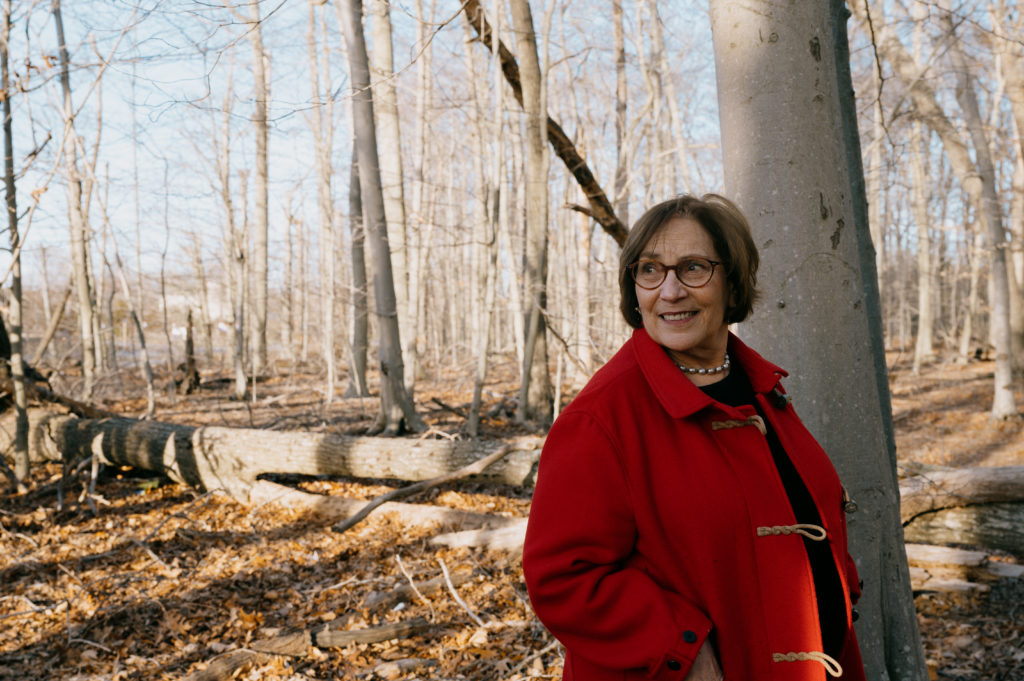
It has not gotten any easier since then. Another 24-unit proposal in Cutchogue, pitched to the town just a few months ago, has been met with community criticism as well.
“Cutchogue Woods,” proposed by Southold resident Rona Smith with Georgica Green Ventures, has been criticized on Facebook and in letters to the Town Board for its potential environmental impact, inability to restrict the lottery to locals only and its location outside a HALO zone, among other things.
A HALO zone, also known as a Hamlet Locus zone, is an area surrounding and including hamlet centers. The town comprehensive plan notes a goal to prioritize “diverse housing” in HALO zones and suggests a zoning analysis to “allow for infill development in areas capable of absorbing more density such as the hamlet centers and HALOs.”
“Of all the development projects currently proposed, the high-density affordable housing proposal for the middle of Cutchogue’s Route 48 farm belt is the most environmentally and visually egregious flouting of sound planning principles, and legally dodgy because it’s spot zoning. And it opens a door to many more such projects,” local resident Gwen Groocock said on Facebook.
“I think we all know that if Rona Smith, the developer behind the ‘Cutchogue Woods’ development was asking for a spot-zone change for a charming country hotel, she’d be laughed out of Town Hall. But because it’s the sacred cow of affordable housing, the Town is going to get woke-shamed into abandoning the very same core planning and preservation principles that made the North Fork succeed in the first place,” she added. “It’s so short sighted.”
“We have a real crisis here.”
Rona Smith
On a call a few weeks after her initial pitch, Ms. Smith said she was surprised by some of the pushback. She had purchased the parcel with the intent to serve what she feels is an urgent need in the community.
“We have a real crisis here. And there’s no competition between various affordable housing developments,” she said. Plus, the parcel may have been developed anyway.
Town Board member Sarah Nappa pointed out on Facebook that the parcel, which is zoned as Agricultural Conservation, is a residential zone and could “just as easily become a large subdivision as this affordable housing project.” Ms. Smith said she had been bidding against someone who wanted to build “McMansions.”
Most of the Town Board supported the “Cutchogue Woods” proposal at a Feb. 1 Town Board meeting, but Supervisor Scott Russell worried that locals would be shut out of the development during lottery selection, pointing to the Vineyard View complex. Twenty-eight of the 50 units went to town residents.
“It’s very hard for me to tell this community of residents that are dying for affordable housing that we’re sorry, we’re going to build this, but we can’t really guarantee you’re going to get any of it, or anybody you know is going to get any of it,” he said at the time.
Applicants for the development would need to fall between 60% and 100% of the Area Median Income of Nassau-Suffolk. Ms. Smith said at a March 1 Town Board work session that they’d raised it to 110%.
The Nassau-Suffolk Area Median Income — median refers to the midpoint, not an average — is $129,900, according to the U.S. Department of Housing and Urban Development. The U.S. Census Bureau estimates the median household income in Southold Town from 2015 through 2019 was $81,094. There are no HUD statistics for AMI by township.
Fair market rent, a HUD statistic developed to determine payments for housing assistance programs, for a two-bedroom dwelling is $2,065 in Nassau-Suffolk. Fair market rent on a two-bedroom dwelling in the 11971 Southold zip code is $1,840. The rate differs based on locality and is updated annually.
Supervisor Russell argued at the Town Board work session that many Southold residents would be disqualified by the income requirements “out of the gate” and criticized the project for accepting public funding, which he said would limit the developer from establishing requirements to select for local applicants.
The federal government offers low-income housing tax credits that subsidize the establishment of affordable rental housing for low- and moderate-income tenants. According to the Tax Policy Center, the program has supported the construction or rehabilitation of more than two million affordable rental units since it was enacted in 1986.
“The federal government issues tax credits to state and territorial governments. State housing agencies then award the credits to private developers of affordable rental housing projects through a competitive process. Developers generally sell the credits to private investors to obtain funding,” the center says.
Owners or developers receiving the tax credits must meet an income test for tenants and a gross rent test. All projects must comply for 15 years and an extended compliance period totaling 30 years is generally imposed, according to the Tax Policy Center.
Affordable units in Southold are distributed through a lottery, with eligible applicants pulled from the town Housing Registry. Qualified active volunteers at agencies providing “firematic protection, emergency medical or ambulance services” in the Town of Southold who are in good standing and have served at least three years are prioritized “in a formula acceptable to the Town Board,” according to town code.
The prioritization measure was adopted in 2019. The town’s Anti Bias Task Force has criticized the amendment for opening “the door to a wide spectrum of possible abuse” and said the prioritization law “on its face, may be discriminatory.”
The town hired a consultant in 2020 to examine federal, state and local laws that could limit the town’s ability to implement the priority status in its housing programs; strategies used by other localities to accomplish similar goals; and ways the town code might need further amendment. The consultant was also tasked with studying how the requirement could translate to projects undertaken with state or federal funds.
“If you talk to three different legal theorists, you’d get three different answers.”
ATTORNEY Eric Dantes
Mr. Russell has argued that privately funded developments could select local applicants for the lottery, but that’s up for interpretation. All housing projects, with very few exceptions, must comply with the Fair Housing Act, which prohibits discrimination in housing based on “race, color, religion, sex (including gender identity and sexual orientation), disability, familial status, or national origin.”
Under the federal law, it’s illegal to make decisions based on those factors, such as refusing to rent or sell housing; otherwise making housing unavailable; setting different terms, conditions or privileges for the sale or rental of a dwelling; advertising sales or rentals that indicate any preferences; or using different qualification criteria, among other things.
Eric Dantes, an attorney and member of both the town HAC and ZBA, said different grants have different requirements. While there is no specific law on the books preventing private funders from adding restrictions, he’d advise against limiting applications to just people from Southold Town.
“If you talk to three different legal theorists, you’d get three different answers. I mean, technically if you go to the laws on the books, yes, you can, but it does open you up to grounds for a lawsuit,” he said.
The way laws are written now, any U.S. taxpayer can apply for publicly funded developments, he added.
“A lot of these grants are originally from federal funding, so the thinking is if people are taxpayers anywhere in the United States, it’s their money and they should receive the benefit,” he said.
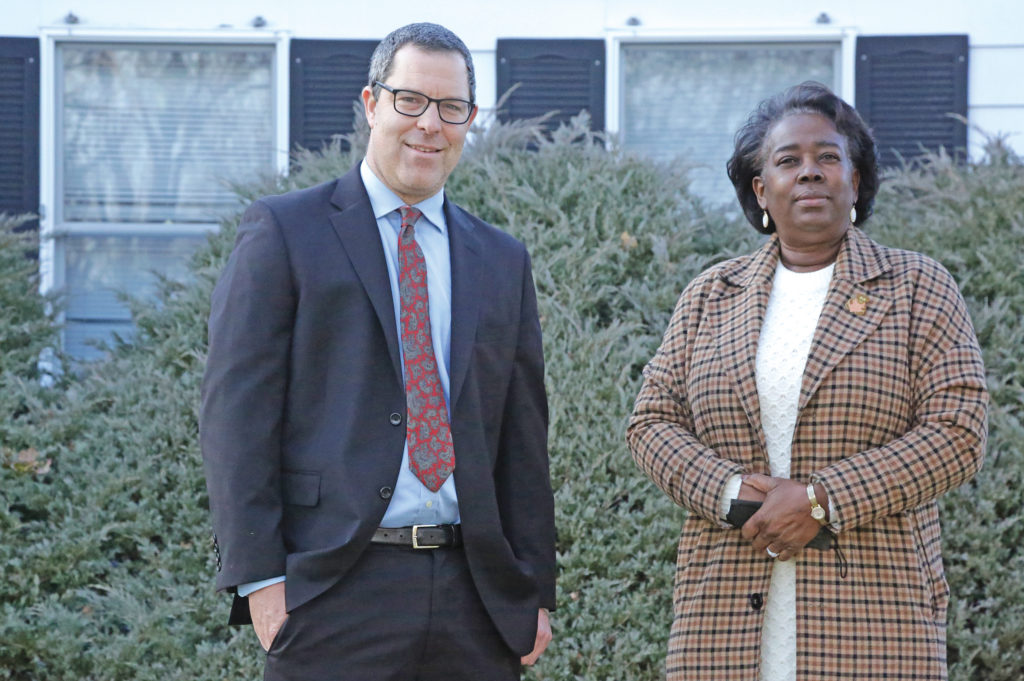
Mitchell Pally, CEO of Long Island Builders Institute, similarly said the issue was complicated in a letter to the editor published in last week’s issue of The Suffolk Times.
“The ability to limit participation in affordable housing lotteries is not solely dependent upon whether the project has public subsidies or not,” he wrote. “The issue of limited participation for any housing also relates to the federal Fair Housing Act and whether such a limit will eliminate or restrict the participation of members of protected groups under federal law.”
Depending on the demographics of a local community, “such a restriction only to local residents may violate the ability of all demographic groups to participate,” he added.
Bill Goggins, a local attorney and developer of the proposed 12-unit development on Depot Lane in Cutchogue, has indicated plans to limit the apartments to local workers. He argued in a Town Board work session last Tuesday that since the project will not use any public funding, taxpayers cannot assert discrimination unless the selection process “violates the Fair Housing Act by discriminating based upon race, color, national origin, familial status or disability.”
“It seems like we’re just setting ourselves up for a lawsuit here.”
Councilman greg doroski
Deputy Town Attorney John Burke said while there is no case law on the books prohibiting private developers from limiting applicants by locality, it does open up the potential for a lawsuit against the landlord and possibly the town.
“I don’t think you have the option of picking who unless on financial grounds,” said Town Board member Louisa Evans. “The only leeway you have there is that people that are volunteers or EMTs, or firefighters. They can have preference, but there’s no preference given as far as where a person’s from. And it’s a lottery system. So it’s not like you can pick who goes in there.”
Town Board member Greg Doroski referred to the consultant’s report from 2020, reading, “A careful review of Fair Housing Law, legal precedents and still pending cases suggest the policy as currently worded, could end up being contested under a variety of legal theories and policy arguments.”
“And here’s the important part,” he said. “The town is advised to remove any semblance of a residency requirement for its current affordable housing policy, and instead find alternative ways of attracting and retaining a diverse essential workforce.”
“It seems like we’re just setting ourselves up for a lawsuit here. There’s an affordable housing crisis in Southold Town and we all want affordable housing here. But we’re setting up this argument that one kind of funding stream is better than another, based on, I think, sketchy legal ground. I’m not an attorney. I’m just reading a report that was done for the town. And I’m concerned,” he said.
Mr. Dantes said many lending and grant programs require in contracts that preferences can’t be built into municipal code.
Privately financed developments are rare, according to Mr. Dantes, although Ms. Smith’s proposal is the only application right now in Southold that would use public funding.
“The majority you’ll see across the country relies on some sort of grant funding or some sort of tax credit funding from a government entity, like low interest loans,” he said. “I think Paul Pawlowski is able to do it in Greenport because he has the commercial aspect of the development. And Bill Goggins is able to do it because it’s very small. But as far as privately financed affordable housing, it’s a rare entity.”
And affordable housing isn’t entirely altruistic; developers get a tax write off, Mr. Dantes said.
“A lot of companies are investing in it because they’d have to pay the taxes anyway,” he said. “They would have to give the money to the IRS or they can invest in affordable housing or some other like program. Maybe they’d make a little bit of money rather than lose it all.”
Even still, it’s a difficult process. And affordable developments are often controversial. East End YIMBY, which aims to educate and advocate for affordable housing, partially arose because of the resistance to local affordable housing developments.
“If we’re not there, the only thing that we can guarantee you is that the people who are against it will be there and even though elected officials may be good intentioned, and even though elected officials may believe that they should be creating affordable housing, the problem is that our zoning has been written in ways to protect the single-family home,” said Mr. Daly, YIMBY founder. “Most anything in most everywhere that does not conform to that single-family zoning is treated as a special exemption and special exemptions are politicized by requiring elected officials to approve them.”
Affordable housing developments have public hearings where people against the development can speak out against the apartments, according to Mr. Daly.
“I really don’t want to leave here, but I may have to.”
Town employee craig jobes
“The problem is, if the elected officials only hear from the people who are against it, which are what we call NIMBYs, then they don’t have the confidence to make the best decision ultimately for the community,” he said.
At a workshop on Sunday, YIMBY members strategized for an upcoming public meeting in East Hampton. A pediatrician said she has to work two full-time jobs to stay on the East End, and lamented staffing shortages and the impact on her patients. Others pointed out that children who grew up in the area are leaving.
In Southold, town employee Craig Jobes has been thinking about leaving the North Fork to escape the rising prices. He grew up in town and has been renting locally for about 10 years now.
“I’ve been fortunate enough that [my landlord is] a family friend, so we still pay a halfway decent price, or else I definitely wouldn’t be around anymore,” he said. “I really don’t want to leave here, but I may have to.”
The affordable housing crisis is urgent, he said. He’s seen friends move away and has others in the same boat as him. He has three kids and two dogs, so an apartment isn’t a feasible option for him, although maybe something like The Cottages at Mattituck could work, he said.
“I’d like to see more small housing developments, like the cottages … stuff like that, rather than apartment complexes,” he said. “When you’re in your young 20s, in the workforce, an apartment is fine. But when you’re in your upper 20s, low 30s with kids and pets and everything else, it’s just not realistic.”
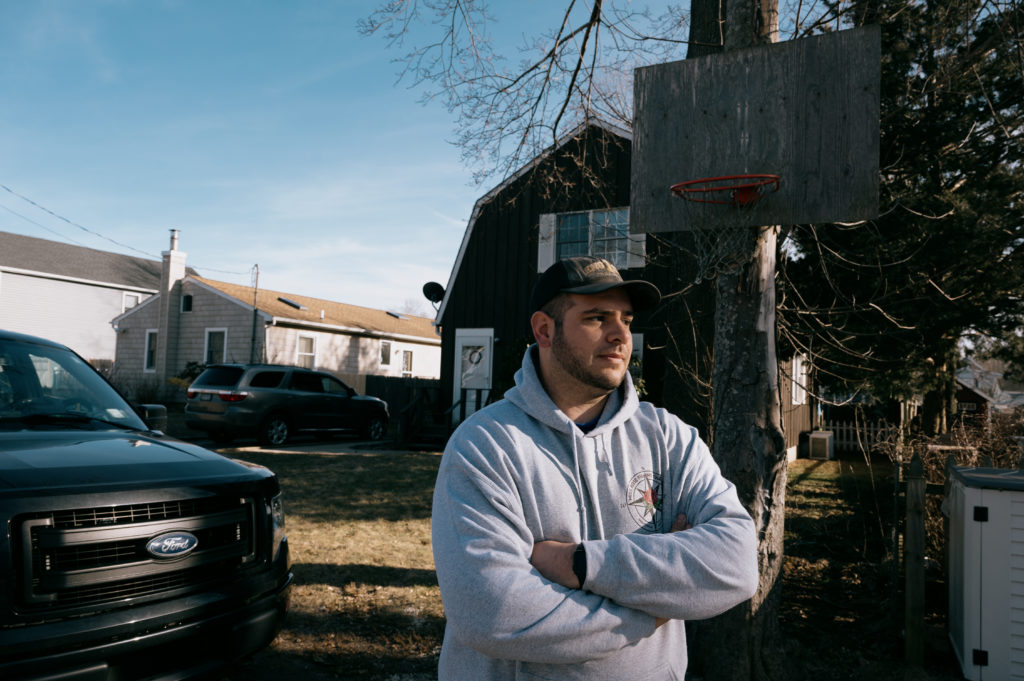
Charles Dumblis, 26, grew up in Mattituck. He said he would consider applying for an affordable apartment, although it’s so competitive that he said it feels “useless.”
“You might get chosen, but there’s so many people competing for it and there’s so few available,” the Hofstra student said.
He said friends who still live out east, with decent paying jobs, are thinking about moving elsewhere. “I’ve come to the point where I realized I’ll probably never be able to afford a house out there. Everything’s so out of reach now, especially the past few years,” he said, even though his “dream” has been to move back.
There is no easy answer, he added. He thinks some affordable apartments aren’t “a bad idea;” but it’s also important to preserve the “special charm” of the North Fork.
Mr. Daly pointed to the expression “a rising tide lifts all ships.”
“That’s not true here in this case,” he said.
Renters and anybody else who doesn’t own their own home have been left “anchored to the bottom while the tide is rising,” he said. “Some of them are drowning and more and more of them are breathing through long straws in order to stay afloat, in order to get oxygen.”
“I don’t know how we’re going to get this done in time to save a lot of our local farmers or local fisherman or local employees and business people that provide hospitality,” he said.
Mr. Daly spoke on a panel hosted by the Mattituck-Laurel Civic Association last Monday, along with developer Ms. Smith and Ms. Lutsky of the HAC.
There’s a lot of “myths,” according to Mr. Daly, that have led to such fervent opposition against affordable housing.
One myth is that affordable housing isn’t for local people, when in reality, there are “thousands of local residents on affordable community housing waiting lists on the East End” and “most affordable units go to local people,” according to East End YIMBY.
Ninety percent of more than 400 applications on file for the town housing registry when The Cottages in Mattituck were proposed were from Southold residents, according to the town comprehensive plan.
Community housing also goes through stringent environmental reviews and complies with building and design regulations; research has shown that affordable housing has no negative impact on home prices; stable housing helps children do better in school; and affordable renters pay taxes and contribute to the local economy, East End YIMBY says.
“I’ve come to the point where I realized I’ll probably never be able to afford a house out there.”
Mattituck native Charles Dumblis
Responding to a question posed at the MLCA panel, Mr. Daly said the AirBnB market on the North Fork has been “nothing short of disastrous.” There needs to be legislation in place to protect a certain number of year-round rentals in each community, he said.
“Most of the rental housing is sort of upon the whim of a landlord,” Ms. Smith said. “So it’s not just AirBnB issues. It’s also issues like somebody who’s rented a house for a while, and suddenly the person sees the prices going through the roof, and they decide to sell their house and the family that’s been living there is out of luck, even though they think of it as their permanent home.”
Lisa Truglio, a nurse at the meeting who described herself as a single mother, said hospitals are overstretched and filled to capacity. “We have to look at the essential workers as resources that are necessary. And it’s not just a moral issue. It’s a smart issue.”
Another audience member, who said he served in the Department of Homeland Security, said the mayor of Santa Barbara, Calif. told him around 15 years ago that the city’s biggest risk was affordable housing.
“[The mayor] said, ‘we do not have one fireman, one policeman or one person working at our hospital who can afford to live in Santa Barbara,’ ” he said. “When you reach those kinds of extremes, who is going to put out the fire?”
On the East End, traffic issues have been exacerbated over the years by workers who can’t afford to live near where they work.
“I kind of refer to that as the Disneyfication of the East End, where the park closes down in the evening and all the employees go home. And then they all have to come back in the morning, causing incredible traffic jams,” Mr. Daly said.
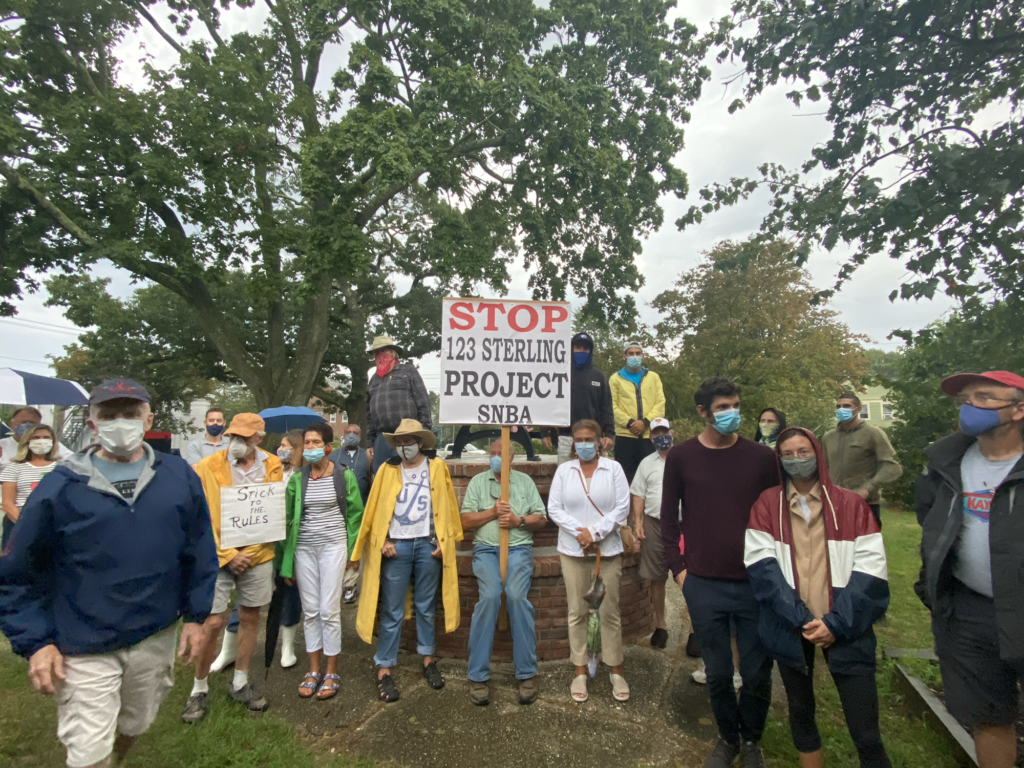
Another audience member asked about Community Housing Funds. In October, Gov. Kathy Hochul signed legislation that allows the five East End towns to hold referendums on adding 0.5% to the existing 2% Community Preservation Fund tax on real estate transactions.
The Town Board briefly discussed the tax at a town work session last Tuesday.
“In order to qualify to have the referendum, you have to have a housing plan,” said Ms. Smith. “Pat [Lutsky] mentioned six different developments that have been proposed. Wouldn’t it be great if somebody in the town put together all of these projects on a spreadsheet and looked at what level of AMI they are going to be renting to, so there can be some coordination and we would know we are hitting all the levels that need the housing, not just some levels? But that doesn’t happen.”
“We’ll never pass a referendum unless people understand the desperation that exists,” she added.
Councilman Doroski, who was at the meeting, responded that there’s no dispute there’s a real need for affordable housing in town, but acknowledged there needs to be some work on a plan.
“I think to Rona [Smith]’s point and the point that Pat [Lutksy]’s making, we really need to define how many units we need, what these units look like, where they’re going to be located, what the AMIs are and what mechanisms we want to use to deliver them,” he said.
“One of the great benefits of this affordable housing plan, that’s part of this Community Housing Act, is that it doesn’t necessarily require multifamily housing to solve this problem. It can be used to deliver grants to first time homebuyers. It can be used to provide grants for accessory apartments, it can be used to help with infrastructure for these larger projects,” Mr. Doroski added.
Letting affordable housing reach a crisis level has only made it more difficult to solve the problem. Southold needs a plan, he said.



